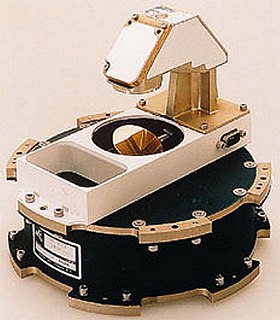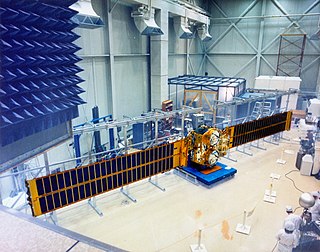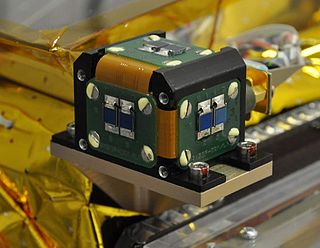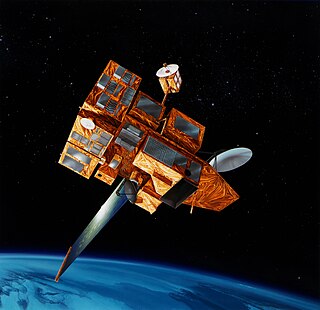Related Research Articles

A reaction wheel (RW) is a type of flywheel used primarily by spacecraft for three-axis attitude control, which does not require rockets or external applicators of torque. They provide a high pointing accuracy, and are particularly useful when the spacecraft must be rotated by very small amounts, such as keeping a telescope pointed at a star.

BeppoSAX was an Italian–Dutch satellite for X-ray astronomy which played a crucial role in resolving the origin of gamma-ray bursts (GRBs), the most energetic events known in the universe. It was the first X-ray mission capable of simultaneously observing targets over more than 3 decades of energy, from 0.1 to 300 kiloelectronvolts (keV) with relatively large area, good energy resolution and imaging capabilities. BeppoSAX was a major programme of the Italian Space Agency (ASI) with the participation of the Netherlands Agency for Aerospace Programmes (NIVR). The prime contractor for the space segment was Alenia while Nuova Telespazio led the development of the ground segment. Most of the scientific instruments were developed by the Italian National Research Council (CNR) while the Wide Field Cameras were developed by the Netherlands Institute for Space Research (SRON) and the LECS was developed by the astrophysics division of the European Space Agency's ESTEC facility.

The Communications Technology Satellite (CTS), known as Hermes, was an experimental high-power direct broadcast communications satellite. It was a joint effort of Canadian Department of Communications, who designed and built the satellite, NASA who tested, launched and operated the satellite, and European Space Agency (ESA) who provided the 1200 watts solar panels and other devices. The three agencies shared the satellite and the data from the experiments.

Project Echo was the first passive communications satellite experiment. Each of the two American spacecraft, launched in 1960 and 1964, were metalized balloon satellites acting as passive reflectors of microwave signals. Communication signals were transmitted from one location on Earth and bounced off the surface of the satellite to another Earth location. The first transmissions using Echo were sent from Goldstone, California to Holmdel, New Jersey on 12 August 1960. The last Echo satellite deorbited and burned up in the atmosphere on 7 June 1969.

Gravimetry is the measurement of the strength of a gravitational field. Gravimetry may be used when either the magnitude of a gravitational field or the properties of matter responsible for its creation are of interest.

Cyberteam in Akihabara is a 1998 Japanese anime television series created by Tsukasa Kotobuki and Satoru Akahori. It aired from April 4, 1998 to September 26, 1998 on TBS and ran for 26 episodes. It was released in the United States by ADV Films and was also broadcast on international networks such as Anime Network, AXN Asia, Locomotion. A 1-hour featured animation film of the series was subsequently released in Japan entitled Cyberteam in Akihabara: Summer Vacation of 2011; unlike the series the film was produced by Production I.G and Xebec. The show has an array of characters, many of whom are named after birds, gods, and real-myth villains.

A small satellite, miniaturized satellite, or smallsat is a satellite of low mass and size, usually under 500 kg (1,100 lb). While all such satellites can be referred to as "small", different classifications are used to categorize them based on mass. Satellites can be built small to reduce the large economic cost of launch vehicles and the costs associated with construction. Miniature satellites, especially in large numbers, may be more useful than fewer, larger ones for some purposes – for example, gathering of scientific data and radio relay. Technical challenges in the construction of small satellites may include the lack of sufficient power storage or of room for a propulsion system.

Space Emperor God Sigma is a mecha anime television series aired from 1980 to 1981. It ran for 50 episodes. It is also referred to as "God Sigma, Empire of Space" and "Space Combination God Sigma".
GIOVE, or Galileo In-Orbit Validation Element, is the name for two satellites built for the European Space Agency (ESA) to test technology in orbit for the Galileo positioning system.

A sun sensor is a navigational instrument used by spacecraft to detect the position of the sun. Sun sensors are used for attitude control, solar array pointing, gyro updating, and fail-safe recovery.
MightySat-2.1, also known as P99-1 or Sindri was a small spacecraft developed by the Air Force Research Laboratory to test advanced technologies in imaging, communications, and spacecraft bus components in space.

Hitomi, also known as ASTRO-H and New X-ray Telescope (NeXT), was an X-ray astronomy satellite commissioned by the Japan Aerospace Exploration Agency (JAXA) for studying extremely energetic processes in the Universe. The space observatory was designed to extend the research conducted by the Advanced Satellite for Cosmology and Astrophysics (ASCA) by investigating the hard X-ray band above 10 keV. The satellite was originally called New X-ray Telescope; at the time of launch it was called ASTRO-H. After it was placed in orbit and its solar panels deployed, it was renamed Hitomi. The spacecraft was launched on 17 February 2016 and contact was lost on 26 March 2016, due to multiple incidents with the attitude control system leading to an uncontrolled spin rate and breakup of structurally weak elements.
Yamazaki-Teiichi Prize is an award given annually by the Foundation for Promotion of Material Science and Technology of Japan (MST) to people who have achieved outstanding, creative results, with practical effect, by publishing theses, acquiring patents, or developing methods, technologies and the like and/or people with strong future potential for achieving such results. Chairman of the selection committee is Professor Hideki Shirakawa, the winner of the 2000 Nobel Prize in chemistry. The prize was established in commemoration of the late Teiichi Yamazaki, the first chairman of the MST's Board of Directors, for his contributions to scientific, technological and industrial development and human resource cultivation.

ADEOS II was an Earth observation satellite launched by NASDA, with contributions from NASA and CNES, in December 2002. Its Japanese name was Midori 2, and it was the successor to the 1996 mission ADEOS I. The mission ended in October 2003 after the satellite's solar panels failed.

An inertial measurement unit (IMU) is an electronic device that measures and reports a body's specific force, angular rate, and sometimes the orientation of the body, using a combination of accelerometers, gyroscopes, and sometimes magnetometers. IMUs are typically used to maneuver aircraft, including unmanned aerial vehicles (UAVs), among many others, and spacecraft, including satellites and landers. Recent developments allow for the production of IMU-enabled GPS devices. An IMU allows a GPS receiver to work when GPS-signals are unavailable, such as in tunnels, inside buildings, or when electronic interference is present.

ASTERIA was a miniaturized space telescope technology demonstration and opportunistic science mission to conduct astrophysical measurements using a CubeSat. It was designed in collaboration between the Massachusetts Institute of Technology (MIT) and NASA's Jet Propulsion Laboratory. ASTERIA was the first JPL-built CubeSat to have been successfully operated in space. Originally envisioned as a project for training early career scientists and engineers, ASTERIA's technical goal was to achieve arcsecond-level line-of-sight pointing error and highly stable focal plane temperature control. These technologies are important for precision photometry, i.e., the measurement of stellar brightness over time. Precision photometry, in turn, provides a way to study stellar activity, transiting exoplanets, and other astrophysical phenomena.
Innovative Satellite Technology Demonstration-1 is a mission to demonstrate various experimental devices and technology in space. It is the first flight in the Innovative Satellite Technology Demonstration Program, managed by the JAXA Research and Development Directorate. The mission includes several spacecraft, the largest being RAPIS-1, along with six smaller satellites. It was successfully launched on 18 January 2019.
ASTER is a planned space mission under development by the Brazilian Space Agency that will launch a spacecraft to orbit a near-Earth object known as (153591) 2001 SN263, a triple asteroid system. The launch is scheduled for 2021, with a rendezvous in 2022.

TSUBAME was a microsatellite developed by the Tokyo Institute of Technology and Tokyo University of Science from a student design concept in 2004. The satellite was designed to demonstrate new technologies for rapid attitude control, observing gamma ray bursts, and earth observation. The name, TSUBAME, means swift in Japanese and was chosen both because of the experimental attitude control system and to invoke another gamma ray observatory, the Swift Gamma-Ray Burst Mission, which launched shortly after TSUBAME's first design concept was published in 2004.
References
- 1 2 3 Variable Shape Attitude Control Demonstration with Microsat "Hibari". Kenichi Sasaki, Yuhei Kikuya, Sho Koizumi, Yuto Masuda, Yusuke Shintani, Tsubasa Tsunemitsu, Takashi Furuya, Yohei Iwasaki, Yuichiro Takeuchi, Kei Watanabe, Saburo Matunaga. Tokyo Institute of Technology. 32nd Annual AIAA/USU Conference on Small Satellites. 2018.
- 1 2 3 4 Variable Shape Attitude Control Demonstration with Microsat "Hibari". (Slide presentation) Kenichi Sasaki, Yuhei Kikuya, ShoKoizumi, YutoMasuda, ToshikiOzawa, Yusuke Shintani, Tsubasa Tsunemitsu, Yuichiro Takeuchi, Yoichi Yatsu, Saburo Matunaga. Tokyo Institute of Technology. 4 August 2018.
- ↑ A Study of Rest-to-Rest Three-Axis Attitude Maneuver with Shape Variable Function. Watanabe Fuuta. Tokyo Institute of Technology. January 2016. doi : 10.1299/jsmesec.2016.25.2B1